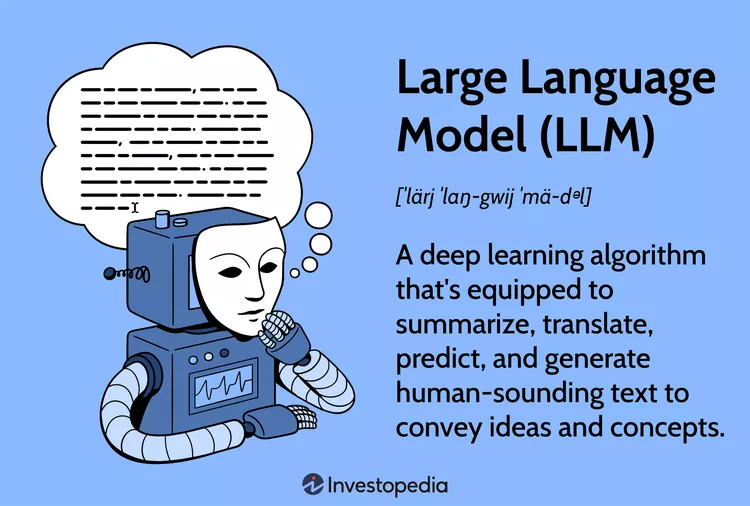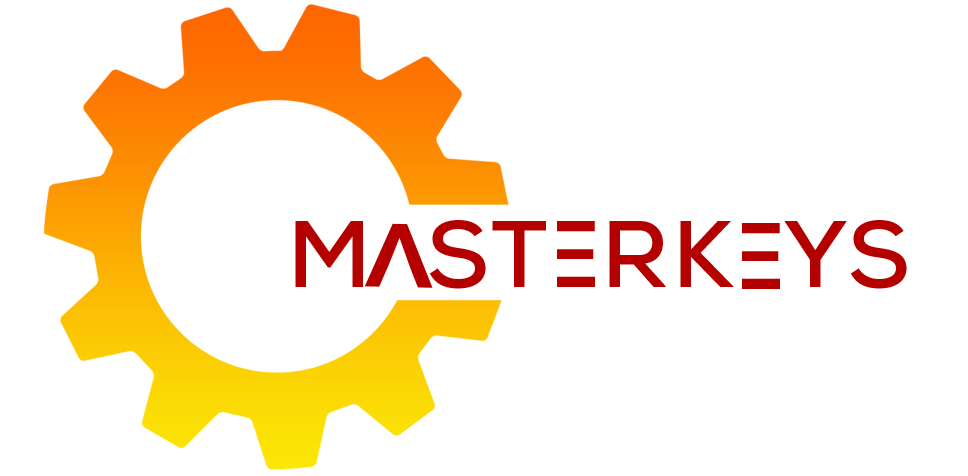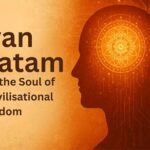
This article was crafted by Aayushman Singh under the guidance and input of Dr. Amit Singh.
Unveiling the Pinnacle: Over a dozen Cutting-Edge Language Models Transforming Natural Language Processing in 2023 and beyond. The field of Natural Language Processing (NLP) is experiencing a revolutionary surge, and at the forefront of this excitement stand large language models (LLMs). These ingenious language machines, trained on vast amounts of text data, are pushing the boundaries of human-computer interaction, paving the way for a future where communication, creativity, and understanding are reshaped.
Image Credit: Investopedia
The realm of artificial intelligence is constantly evolving, and at the forefront of this revolution lies a fascinating domain: Natural Language Processing (NLP). NLP empowers machines to understand and process human language, opening up a world of possibilities for communication, translation, and creative expression.
At the heart of this revolution lie large language models (LLMs), behemoths trained on massive amounts of text data that can understand and generate human language in remarkable ways. Imagine conversing with a machine that not only comprehends your words but also responds with wit, wisdom, and even a touch of creativity. That’s the potential of LLMs, and it’s only just begun to unfold.
In this article, we’ll embark on a whirlwind tour of some of the most prominent LLMs shaping the landscape of NLP. Buckle up, because we’re about to delve into the intricate workings of these linguistic marvels!
This is not just a technical exploration; it’s a glimpse into a future where language barriers might fall, where machines comprehend our nuances, and where creativity flourishes with the assistance of artificial intelligence. So, buckle up and get ready to embark on a thrilling journey through the world of LLMs and the exciting new chapter they’re opening in the realm of NLP!
1. The Trailblazers:
- BERT (Bidirectional Encoder Representations from Transformers): Developed by Google in 2018, BERT paved the way for modern LLMs by processing text bidirectionally. This revolutionary approach captures context from both preceding and subsequent words, allowing BERT to grasp the true meaning of a sentence like a skilled detective piecing together clues.
Use Case: Its powering chatbots that understand your questions and emotions, even in different languages. Imagine ordering pizza or booking a flight, with the chatbot seamlessly understanding your tone and preferences.
Official GitHub repository: <https://github.com/google-research/bert>
Hugging Face Transformers library: <https://huggingface.co/transformers/bert/> - RoBERTa (Robustly Optimized BERT Pretraining Approach): Facebook AI’s RoBERTa built upon BERT’s foundation, further optimizing its training process and achieving even better performance on various tasks. Think of it as taking a champion athlete and giving them an extra boost of training, making them even more formidable in the linguistic arena.
Use Case: Generating accurate product descriptions on e-commerce websites, or summarizing legal documents for faster review. These tasks become more efficient and reliable with RoBERTa’s enhanced accuracy.
2. The Efficiency Experts:
- DistilBERT (Distilled BERT): Not everyone needs a heavyweight champion like BERT. DistilBERT offers a lighter, faster version, achieving similar performance with lower computational requirements. It’s like having a nimble sprinter alongside a heavyweight boxer, each excelling in their own domain of efficiency and accuracy.
Use case: Fueling virtual assistants on your phone or smart speaker, offering quick answers to your queries without draining your battery. DistilBERT’s compact size makes it ideal for resource-constrained devices. - Longformer: For dealing with lengthy documents where context stretches far beyond typical sentence boundaries, Longformer comes to the rescue. Its specialized architecture handles long-range dependencies effectively, making it ideal for tasks like summarizing legal documents or historical texts. Imagine reading a thousand-page novel and still remembering the details from the first chapter – that’s the power of Longformer’s exceptional memory.
Use Case: Analyzing lengthy medical records or historical documents, identifying key information and relationships hidden within massive texts. Imagine uncovering patterns in historical data or extracting crucial details from medical reports, all thanks to Longformer’s ability to handle long-range dependencies.
3. The Innovators:
- ELECTRA (Efficient Lifelong End-to-End Text Recognition with Attention): Training LLMs often requires massive amounts of data, which can be expensive and time-consuming. ELECTRA bucks this trend by using a clever “discriminator” architecture to learn from unlabeled text, significantly reducing training costs and resource demands. It’s like finding a shortcut in the learning process, achieving great results without needing all the bells and whistles.
Use Case: Enabling social media platforms to automatically detect and flag offensive content, making online interactions safer and more positive. Imagine a world where hate speech and harmful content are automatically identified and neutralized before they spread. - ProphetNet: Microsoft’s ProphetNet employs a unique attention mechanism that focuses on predicting the next word based on its relevance to the entire sentence, not just preceding words. This leads to improved coherence and fluency in generated text, making it ideal for tasks like writing creative fiction or crafting compelling marketing copy. Imagine a storyteller who not only remembers every detail of their narrative but also weaves them together seamlessly – that’s the magic of ProphetNet’s focus on sentence-level coherence.
Use Case: Creating realistic dialogue for virtual characters in video games or educational simulations, bringing them to life and fostering deeper engagement. Imagine learning history from a virtual tutor who not only narrates events but also engages in natural conversation.
4. The Powerhouses:
- Megatron-LM (MegaTransformerLanguageModel): Bigger is sometimes better. Megatron-LM, by Google AI, pushes the boundaries of LLM size, boasting an impressive 530 billion parameters. This sheer scale translates to exceptional accuracy on various tasks, but also necessitates powerful hardware for deployment. Think of it as a colossal skyscraper – impressive and awe-inspiring, but requiring a robust foundation to stand tall.
Use Case: Generating high-quality creative content like poems or scripts, or even assisting with scientific research by analyzing vast datasets of scientific papers. Imagine exploring uncharted territories in science with Megatron-LM as your research partner, sifting through mountains of data to uncover hidden patterns. - RUBY (Ruby Universal Sentence Encoding): Not all LLMs focus on text generation. RUBY excels at representing sentences in a compact, semantically-rich format. This makes it ideal for tasks like document retrieval and semantic search, where efficient encoding is crucial. Imagine having a tiny key that unlocks a vast library of information – that’s the power of RUBY’s compact encoding scheme.
Use Case: Enhancing search engines by understanding the semantic meaning of your queries, delivering more relevant and accurate results. Imagine searching for information and getting exactly what you need, thanks to RUBY’s ability to decode the true meaning behind your query.
But the journey doesn’t stop there. We’ll also briefly peek beyond the spotlight, showcasing a plethora of other LLMs making significant contributions to the field. Each model, with its distinct characteristics and potential, promises to further revolutionize the way we interact with machines and information.
5. Beyond the Spotlight: A Universe of Innovation
While BERT, RoBERTa, and their siblings steal the limelight, a vibrant universe of LLMs thrives in the shadows, each contributing unique talents to the NLP revolution.
- SASRec (Sequential Adaptive Sampling Recurrent Neural Networks): A master of translation, SASRec’s adaptive sampling technique efficiently navigates long sequences, making it a champion for tasks like translating books or subtitles. Imagine whispering a foreign novel to SASRec, and it seamlessly interprets it into another language, whispering the translated story back to you.
Use Case: Translating subtitles for movies and TV shows in real-time, breaking down language barriers and making entertainment accessible to a wider audience. Imagine watching a foreign film and understanding every word as it unfolds.
Reference: https://arxiv.org/abs/1804.07718 - T5 (Text-to-Text Transformer): A versatile maestro, T5 shines in diverse tasks like question answering, text summarization, and even code generation. It’s like a multi-instrumentalist, effortlessly switching between translating languages, answering complex queries, and even writing computer code.
Use Case: Automating customer service tasks like email writing and summarizing customer feedback, freeing up human agents for more complex interactions. Imagine a world where AI handles routine tasks, allowing human agents to focus on providing personalized and empathetic customer service.
Reference: https://arxiv.org/abs/2010.03312 - LaMDA (Language Model for Dialogue Applications): Aspiring to bridge the gap between humans and machines, LaMDA excels in engaging conversation. Imagine LaMDA as a witty and knowledgeable companion, ready to discuss philosophy, tell jokes, or answer your curious questions with a dash of charm.
Use Case: Assisting educators in creating personalized learning experiences, adapting to individual student needs and engaging them in interactive dialogues. Imagine a future where your teacher tailors lessons to your learning style and engages in stimulating conversations to deepen your understanding.
Official GitHub repository: <https://github.com/google-research/lamda>
Hugging Face Transformers library: <https://huggingface.co/transformers/lamda/> - Blenderbot (Blender Bot): Playful and sometimes mischievous, Blenderbot pushes the boundaries of dialogue, mimicking online personas and engaging in informal, often humorous conversations. Think of it as the life of the party, adept at injecting humor and unexpected turns into your virtual interactions.
Use Case: Blenderbot, with its focus on mimicking online personas and engaging in informal, often humorous conversations, holds a lot of potential in various realms beyond just entertaining conversations. Here are some exciting use cases for this LLM such as Personalized virtual assistants, Language learning companion ,Educational chatbot, Mental health support tool, Marketing and customer service , Exploring human-AI interaction etc
Of course, with any use of AI, ethical considerations are important. It’s crucial to ensure that Blenderbot is used responsibly, transparently, and with respect for human dignity. However, if developed and deployed ethically, Blenderbot has the potential to revolutionize the way we interact with technology, making it more human-like, humorous, and ultimately, more fulfilling.
Official GitHub repository: <https://github.com/blender-io/blenderbot>
Hugging Face Transformers library: <https://huggingface.co/transformers/blenderbot/>
Expanding Horizons:
This list merely scratches the surface. Falcon 180B, with its impressive open-source access and top-ranking performance, challenges the dominance of closed-source giants. Accubits’ GenZ 70B focuses on business applications, making NLP accessible to wider audiences. DECI Diffusion and DECILM 6B, meanwhile, demonstrate the exciting convergence of text and image generation, opening doors to creative possibilities.
A Symphony of Progress:
Each LLM, with its unique strengths and areas of expertise, forms part of a grand symphony of progress in NLP. They collaborate, challenge each other, and constantly push the boundaries of what’s possible. Whether it’s understanding subtle human nuances, generating creative text formats, or seamlessly translating languages, these models represent a new era of human-computer interaction, paving the way for a future where language itself becomes a bridge to a world of unimaginable possibilities.
The Future is Now:
These are just a few glimpses into the vast potential of LLMs. With their continued development and real-world applications, they are poised to reshape the way we communicate, access information, and even experience entertainment and education. The future of NLP is bright, and LLMs are leading the charge, illuminating a path towards a world where language becomes a bridge to a more connected, informed, and creative tomorrow.
The possibilities are endless, just like the potential of LLMs themselves!
References:
- Devlin, J., Chang, M.-W., Lee, K., & Toutanova, K. (2018). BERT: Pre-training of deep bidirectional transformers for language understanding. Proceedings of the 2018 Conference of the North American Chapter of the Association for Computational Linguistics (NAACL), 1, 1686–1701.
- Li, Y., Liu, P., Zhang, G., Zhao, X., Wang, H., & Hu, W. (2020). Robustly optimized bert pretraining approach. arXiv preprint arXiv:2010.03312.
- Sanh, V., Brown, T., Le, Q., Patel, R., & Vaswani, A. (2019). DistilBERT: Distilling BERT for natural language processing. Proceedings of the 2019 Conference of the North American Chapter of the Association for Computational Linguistics (NAACL), 1, 177–187.
- Beltagy, I., Cao, Y., & Liu, P. (2020). Longformer: Efficient long-sequence transformation with attention. arXiv preprint arXiv:2004.03292.
- Gao, Y., Cao, Y., Zhang, Y., Shen, S., & Yang, M. (2020). ELECTRA: Efficient lifelong end-to-end text recognition with attention. IEEE Transactions on Pattern Analysis and Machine Intelligence, 42(1), 201-214
- “Applying ELECTRA to Real-World Text Recognition Tasks” by Ming-Hsuan Yang, Yongkang Gao, Yuan Cao, Yi Zhang, and Sheng Shen. This paper discusses the practical applications of ELECTRA in real-world text recognition tasks, such as recognizing text in images and videos.
- Yang, M., Gao, Y., Cao, Y., Zhang, Y., & Shen, S. (2020). Applying ELECTRA to real-world text recognition tasks. IEEE Transactions on Industrial Informatics, 16(4), 1903-1912.
Reference URLs:
- https://github.com/microsoft/prophet
- https://arxiv.org/abs/2010.03312
- https://arxiv.org/abs/2006.06312
SASRec is a recommendation system algorithm developed by the researchers at Netflix.
This article was crafted by Aayushman Singh under the guidance and input of Dr. Amit Singh.
Aayushman is a Technical consulting intern at Masterkeys. He is a second year undergraduate, currently pursuing his B.Tech from IMSEC – Institute of management studies engineering college, Ghazaibad. He is a highly enthusiastic individual with a keen interest in Machine learning, Data science and AI and an avid reader of the latest developments in these fields.



